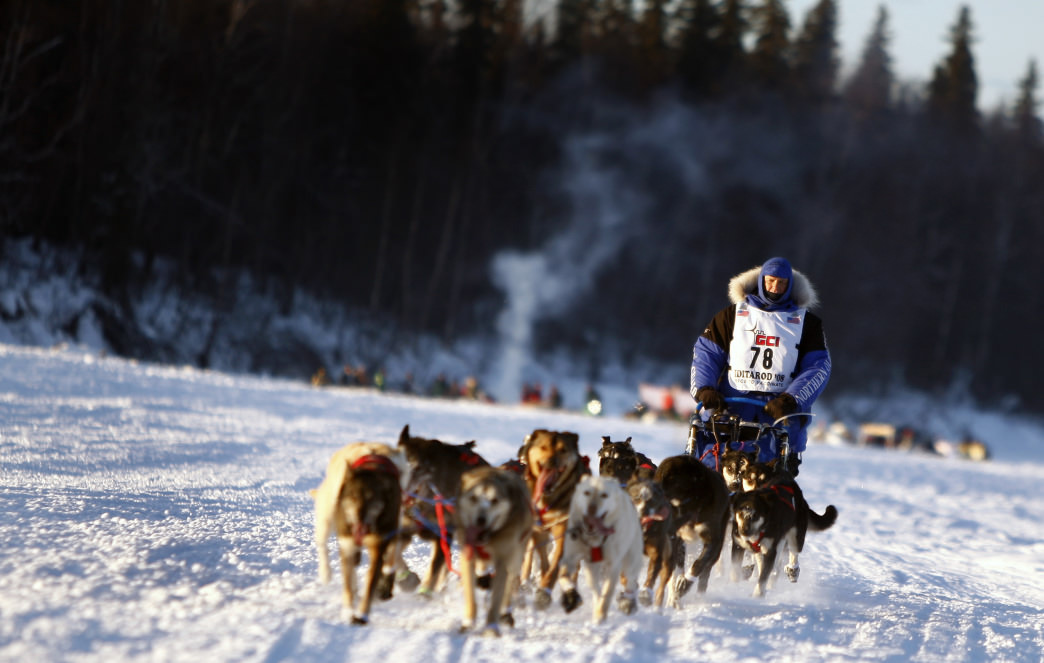They line up in Willow, all in a row, hundreds of yapping pups with their mushers in tow.
The crowds cheer, and everyone knows that this is the moment they’ve been training all those months for. Anticipation is mounting, but they still have a long journey ahead—1,150 miles to be exact—until they reach the finish line in Nome.
This is, of course, the Iditarod: the world-famous dog sledding event that takes place annually in Alaska, and is known as the "Last Great Race on Earth." Each year in early March, dozens of mushers and their teams of 12 to 16 dogs journey across remote tundra and spruce forests, over mountain passes and across rivers, through white-outs and gale-force winds for days (or even weeks) before reaching the end of the historic Iditarod Trail.
Given its length, extreme conditions, and remote nature, the race is no less than harrowing. "Every single day brings new challenges," two-time Iditarod musher Monica Zappa says. “Things are bound to happen when you’re covering that much wilderness in the winter.” While most of the physical exertion falls on the dogs, mushers battle extreme mental fatigue from making the non-stop tough decisions required to lead their canine crew, and also from sleep deprivation: most mushers only get about two to three hours of sleep a day for the approximately two weeks they’re out on the trail.

The U.S. Army
But the foreboding reputation is also part of the draw. "It’s one of those races that all mushers want to do at some point in their life," Zappa says. “It’s on everyone’s bucket list.” The $70,000 and new truck awarded to the winner can’t hurt as motivation, either.
The Iditarod Trail was once a lifeline for people living in rural Alaska, and in the winter dogsledding was the usual means by which it was traveled. Mushers and their dogs took the trail to deliver mail and supplies between the isolated villages. Most famously, when the children of Nome were hit by a diphtheria epidemic in 1925, sled dogs led by the legendary Balto used the trail to deliver a life-saving serum from Anchorage.
The invention of the snowmobile made dogsledding obsolete, and by the 1970s mushing was a dying Alaskan tradition. In an effort to revive the practice, Joe Redington, Sr. devised a dogsledding race along the Iditarod Trail—and thus, on March 3, 1973, the "Last Great Race on Earth" was born.
These days, Iditarod (locals typically refer to the race without the "the") is a prized annual event. The celebration kicks off before the race with the Fur Rendezvous (also known as the Fur Rondy). This 10-day festival in Anchorage features ice skating, a scavenger hunt, and even the Alaskan version of Pamplona’s Running of the Bulls with the ‘Running of the Reindeer.’
What You Need to Know if You Decide to Go

Photo by John Pennell/JBER PAO
"It’s sort of the ‘end of the long dark winter festival,’" Anchorage native and Iditarod volunteer Jesika Reimer explains. The week is also a good chance to get to know the mushers, as many Iditarod participants hold meet-and-greets and present slideshows at various hotels throughout the city. The Millennium Alaskan Hotel is the official Iditarod Race headquarters, so if you want to be in the thick of the action, book a room there.
Rondy Fur leads right up to the ceremonial Iditarod start, which beings in downtown Anchorage on the first Saturday in March. Thousands of spectators line the streets to see the action as the dog teams parade a few miles through town before the real deal begins the next day. Reimer says it’s a good idea to stake out a good spot early because it will be crowded! And while this is a dog-centered event, it’s also important to note that it’s best to leave your own pets at home: musher Monica Zappa says their presence can interfere with the race dogs.

Bering Land Bridge National Pres
While the ceremonial start is all about merrymaking and show, the official start the next day is all business. The traditional restart took place in Wasilla, about 40 miles northwest of Alaska. But in recent years there hasn’t been enough snow in Wasilla, and so they have moved it 40 miles further north, to Willow. (Race organizers truck snow in for the ceremonial start in Anchorage when they have to.) In 2015 the dearth of snow actually forced race organizers to move the start to Fairbanks, 350 miles north of Anchorage, but this year it is on track in Willow.
Once the race is underway, there are fewer opportunities to spectate—the checkpoints are hard to access if you’re not on a dogsled, but some companies organize tours where you can fly to various checkpoints to greet the mushers.
If you’re looking for a more affordable option to get closer to the race, think about applying to volunteer. One of the volunteer positions is to care for dogs that have had to drop out at some point along the race (and are then transported back to the Millennium Hotel in Anchorage).
"Basically the job description is petting and loving dogs and making them comfortable," Reimer explains. Sign me up!
Originally written by RootsRated for Craghoppers.
Featured image provided by U.S. Army photo by Russel Lee Klika

 A musher and his team out on the trail.
A musher and his team out on the trail.